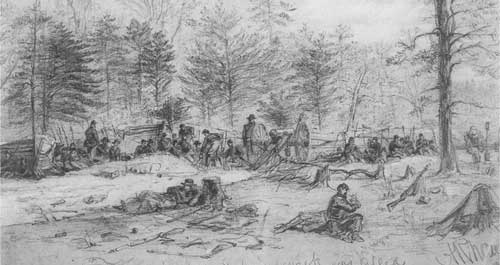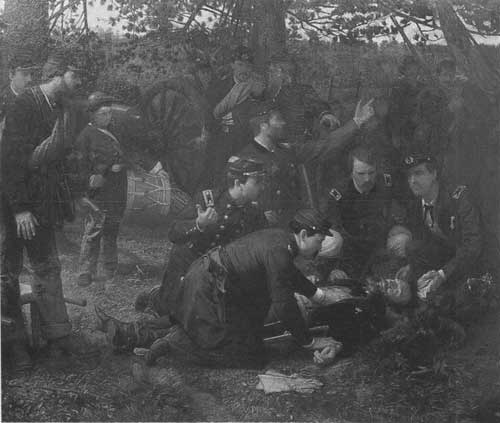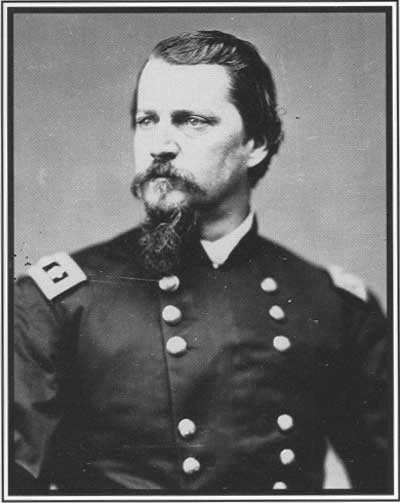|
MAY 9: A SHARPSHOOTER KILLS SEDGWICK
The sun rose on May 9 to reveal a network of earthen fortifications
sprawling above Spotsylvania Court House. The Confederate line started
near the Po, followed Laurel Hill east across Brock Road, then lunged
forward to form a horseshoe-shaped bulge encompassing high ground around
the Harrison and McCoull places. Federal entrenchments wound through
fields and woods across from the Rebels. A Union reporter thought that
"it was Gettysburg reversed—Lee having the inner circle." The
salient—or "Muleshoe," as the projecting earthworks were
called—concerned Lee's engineers because it constituted a
vulnerable point in the Rebel position. They deemed it a "necessary
evil," however, as it was important to include high ground within the
salient.
Ewell's Confederate Second Corps occupied the Muleshoe. The
Southerners dug trenches with cups and bayonets, felled trees in front
to create clear fields of fire, then stacked the timber with sharpened
branches facing the enemy, intending to delay the Yankees while they
shot them to pieces. Earthworks were erected in front of the trenches
and head logs were thrown on top with "loopholes" for firing. Every so
often barricades—called "traverses"— extended back at right angles
from the main works to protect the Rebels from flanking fire and to give
them rallying points if the Federals broke through. Meade's chief of
staff, Major General Andrew A. Humphreys, remarked that "with such
entrenchments as these, having artillery throughout, with flank fire
along their lines wherever practicable, and with the rifled muskets then
in use, which were as effective at three hundred yards as the
smooth-bore muskets at sixty yards, the strength of an army sustaining
attack was more than quadrupled."
A Confederate in the Stonewall Brigade wrote home: "Wonder what
General Grant thinks of Master Bob today, for he is right in his way to
Richmond."

|
TWO GUNS OF CAPTAIN WILLIAM H. MCCARTNEY'S FIRST MASSACHUSETTS BATTERY
STOOD AT THE POINT WHERE THE TWO BRANCHES OF THE BROCK ROAD JOINED. JOHN
SEDGWICK WAS STANDING BESIDE THE GUNS WHEN A CONFEDERATE BULLET PIERCED
HIS SKULL. (LC)
|
Around nine o'clock in the morning, Sedgwick inspected his
dispositions near Brock Road. Rebel sharpshooters were active and had
already shot Brigadier General William H. Morris in the leg. Bullets
spattered around and men began ducking. "What! What! Men dodging this
way for single bullets," Sedgwick exclaimed. "What will you do when they
open fire along the whole line. I am ashamed of you. They couldn't hit
an elephant at this distance." Just then a sergeant dropped to his
knees, and Sedgwick prodded the man with his boot. "What are you
dodging at?" Sedgwick inquired. "They can't hit an elephant at that
distance." The sergeant explained that he believed in dodging and
thought that the practice had once saved his life. "All right, my man,"
Sedgwick laughed. "Go to your place." There was another shrill whistle
and a dull thump. Blood spurt like a little fountain from under
Sedgwick's left eye, and the fatally wounded general collapsed into an
aide's arms.

|
SEDGWICK WAS AMONG THE HIGHEST-RANKING OFFICERS KILLED IN THE WAR. WHEN
TOLD OF HIS DEATH, GRANT TWICE ASKED, "IS HE REALLY DEAD?" (COURTESY OF
THE HISTORICAL SOCIETY OF PLAINFIELD/DRAKE HOUSE MUSEUM, PLAINFIELD, NEW
JERSEY)
|
Sedgwick's death was sorely felt. "From the commander to the lowest
private, he had no enemy," an aide scrawled to his family. Meade
appointed Major General Horatio G. Wright as the Sixth Corps' new
head.
The day's chief activities occurred on the flanks. Burnside's corps,
which was quartered near Alrich's, began south along the Fredericksburg
Road. Brigadier General Orlando B. Willcox's division reached the Gayle
house above the Ni, threw skirmishers over the creek, then advanced
partway up the far bank to the Beverly house. There they met determined
resistance from Fitzhugh Lee's mounted Confederates. Fighting sputtered
back and forth until about noon, when Brigadier General Thomas G.
Stevenson's division pulled up and joined Willcox. Burnside was
concerned, however, that his corps projected dangerously in front of Meade
and directed Willcox and Stevenson to entrench.
From his observation post at the Gayle house, Willcox could see
church spires near Spotsylvania Court House. He was distressed to see
Confederates there and expressed concern that they might attack.
Meanwhile, Hancock, who was still near Todd's Tavern, reported that
Early had left his sector. Grant concluded from Willcox's and Hancock's
intelligence that Lee must be shifting from west to east, possibly to
thrust toward Fredericksburg. Sheridan had left on his raid toward
Richmond, so Grant was without his mounted arm to gather information.
Nonetheless, based on the reports from his flanks, he decided to exploit
Lee's apparent maneuver and launch an offensive of his own. Burnside
was to hold the Ni while Hancock advanced to the Po and attacked Lee's
western flank. Burnside would be the anvil and Hancock the hammer while
the rest of the Union army—Warren and Wright—watched for an
opening to attack across Lee's entire line.
Grant visited Hancock late in the afternoon. Union artillery opened
on Confederate wagons across the Po, and soon Hancock's infantry was
splashing across. By dark, most of the Federal Second Corps was over the
river and massing near Block House Bridge, near the left end of Lee's
line. The river bent sharply south at the bridge, which meant that
Hancock would have to cross the Po a second time to reach the enemy.
Fearing that Lee had the bridge heavily guarded, Hancock deferred
advancing until the next morning. Pontoons were thrown across the Po at
the initial crossing to expedite Hancock's retreat, should it become
necessary.

|
WITH A BOOMING VOICE AND COMMANDING PRESENCE, WINFIELD HANCOCK INSPIRED
CONFIDENCE ON THE BATTLEFIELD. (NA)
|
Hancock's delay cost Grant dearly. Under cover of darkness, Lee
withdrew two divisions of Early's corps from Spotsylvania Court House
and rushed them toward the endangered Po River sector. Mahone formed
across the Confederate flank while Heth circled below Hancock, then
swung north to strike the Federal Second Corps' flank. In a move
characteristic of his military style, Lee was turning the tables on
Grant.
|
|
